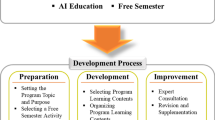Abstract
The teaching of science and technology in the final year of high school is examined in a new curriculum developed for the education system in Victoria, Australia. The traditional areas of Physics and Chemistry together with a technology related subject, Materials and Technology, are investigated The major curriculum link amongst these studies was the area of materials. In Chemistry this involved the nature of materials, the chemical basis for the production of metals and polymers, and the social consequences of waste disposal. Within Physics, the major involvement was the investigation of the structure and physical properties of materials through theory and practical investigation. The selection of materials, production of components and their testing were the major area involved with Materials and Technology. Although the area of materials related all three subjects enrollments were comparatively high for Physics and Chemistry but Materials and Technology had less than one tenth as much enrollment. Similarly, school providers were significantly lower for materials and technology. Materials and Technology is still considered a vocational subject compared with the science oriented subjects. When gender enrollments were considered, Chemistry had a similar number of females and males, Physics had twice as many males as females, and Materials and Technology had twice as many males as females. This appears to be a consequence of typical gender roles.
Similar content being viewed by others
REFERENCES
Abbaschian, R. (1990). Materials education—a challenge, MRS Bulletin 15:8, 18–22.
Dekkers, J., and De Laeter, J.P. (1994). Enrollment trends for nontraditional science subjects in the upper secondary school, Australian Science Teachers Journal 40:2, 24–29.
Delmonte, J. (1985). Origins of Materials and Processes, Technomic, Lancaster.
Fensham, P. J. (1990). What will science education do about technology, Australian Science Teachers Journal 36:3, 8–21.
Finniston, M. (1980). Engineering our Future, Report of the Commission of Inquiry into the Engineering Profession, Cmnd 7794, HMSO, London.
Gardner, P. L. (1993). Science and Technology: Rethinking the Relationship, paper presented at the International Conference on Science Education In Developing Countries, Jerusalem, 3–8 January.
Holman, J. (1987). Resource or course? Contrasting approaches to the introduction of industry and technology in the secondary Curriculum, School Science Review, 68:244, 432–438.
Kranzberg, M., and Smith C. S. (1988), Materials in History and Society, in Forester, T. (ed.) The Materials Revolution, Blackwell, Oxford.
National Academies of Science Engineering and Medicine, (NASEM), (1985), New Pathways in Science and Technology, Vintage Books, New York.
NSF (1989). Materials Science and Engineering for the 1990s: Maintaining Competitiveness in the Age of Materials, National Academy of Sciences, Washington D.C.
NSF (1990). Report of the National Science Foundation Undergraduate Curriculum Development Workshop in Materials, October 11–23, Washington D.C.
Roy, R. (1991). A New Approach to K-12 education: materials as part of applied science and technology, J. Materials Education, 13:1–2, 133–150.
Stokes, R. J. (1990). Materials Science education in the U.S.A and UK: the industrial influence, Materials Science and Technology, October 6:930–933.
Tregust, D.F., and Rennie, L. J. C. (1993). Implementing technology in the school curriculum: a cases study involving six secondary schools, J. Technology Education, 5:1, 1–10.
The Equal Opportunity Action for Girls in Education (1988–1990). Victorian State Government, State Printing Office, Melbourne.
VBOS (1994a). Chemistry Development Study Design 1994–1998, Victorian Board of Studies, Carlton.
VBOS (1994b). Materials & Technology Study Design 1994–1998, Victorian Board of Studies, Carlton.
VBOS (1994). Annual Report of the Victorian Board of Studies, 1993–1994, Victorian Board of Studies, Carlton.
VBOS (1996). Physics Course Study Design, 1997–2000, Victorian Board of Studies, Carlton.
Wnek, G. F., and Ficola, P. J. (1993). Chemistry of materials: an engineering approach to freshman chemistry, Proceedings of the ASEE, session 2531, 1173–1176
Woolnough, B.E. (1988). Technological education and science in schools, Report of the Science and Technology Sub-Committee, Hatfield, England, Association for Science Education.
Author information
Authors and Affiliations
Corresponding author
Rights and permissions
About this article
Cite this article
Blicblau, A.S. The Trend Towards Materials in Science and Technology Education. Journal of Science Education and Technology 6, 231–240 (1997). https://doi.org/10.1023/A:1022531924460
Issue Date:
DOI: https://doi.org/10.1023/A:1022531924460




